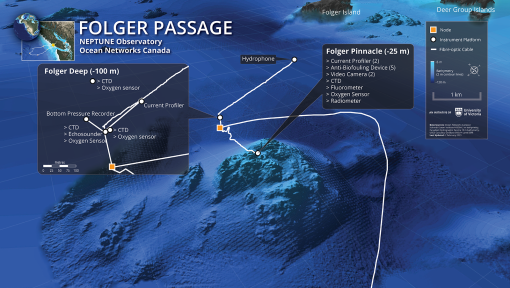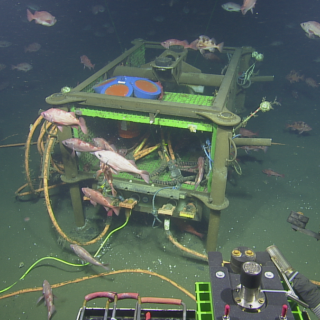Get to Know the 5 Regions of ONC’s Cabled Observatory

Our third expedition of 2023, NA151, sees OET sailing E/V Nautilus to the Northeast Pacific to partner with Ocean Networks Canada (ONC) in ocean exploration and maintenance of the major cabled observatory, NEPTUNE (North-East Pacific Time-series Underwater Networked Experiments). OET and ONC, an initiative of the University of Victoria, will embark on June 25 on this 22-day expedition that starts and finishes in Sidney, British Columbia—marking the seventh year in our partnership. Below is a summary of the five study sites we’ll be visiting during this expedition.

Folger Passage
The closest site to shore, Folger Passage lies in the mouth of Barkley Sound just southwest of Vancouver Island. ONC has two instrument platforms here: one at Folger Deep (95m) and the other at Folger Pinnacle (23m). These sites are much shallower than the others, allowing views of rich biodiversity where terrestrial and marine ecosystems collide, including nearshore reefs that are intimately linked to Canada’s fisheries.
Cascadia Basin
ONC’s deepest site lies 2,660m on the abyssal plain region of the Juan de Fuca Plate. Cascadia Basin includes a few isolated seamounts that act as conduits allowing hydrologic exchange between the open ocean and upper oceanic crust (the largest aquifer of the planet). Home to an assortment of specifically-adapted organisms, ONC’s tools at Cascadia Basin are designed to study the hydrology, geochemistry, and microbiology of the upper oceanic crust.
Clayoquot Slope
About 20km landward of the toe of the Cascadia subduction zone and 1,250m deep lies Clayoquot Slope. In this location, where Juan de Fuca Plate subducts beneath the North American Plate, pore waters are expelled from the sediment, forming cold-water vents like Bullseye Vent, as well as gas hydrates and gas seeps. The name Clayoquot (pronounced “Clah-quot”) is an anglicized version of Tla-o-qui-aht, the largest nation in the Nuu-chah-nulth (Nootka) First Nations.
Barkley Canyon
Located at the edge of the Cascadia subduction zone, about 400m down the continental slope to the canyon axis at 985m, Barkley Canyon is a unique site for exposed gas hydrates to be stable on the seafloor. With the widest array of ONC instruments, spread over the highest number of platforms on one node, this site supports the study of the accretionary prism, where the sediments pile along the continental slope as they are scraped off the subducting tectonic plate.
Endeavour
Perhaps the most famous of ONC’s study sites, Endeavour sits 2,300m deep along the northern segment of the Juan de Fuca mid-ocean ridge where new ocean crust emerges as the Pacific and Juan de Fuca tectonic plates diverge. Here we can spot spectacular hydrothermal vents (protected via the Endeavour Vent Field Marine Protected Area) with tall sulfide chimneys hosting unique ecological communities.

Ocean Networks Canada Maintenance and Exploration
For this expedition, we take a trip north to provide support to Ocean Networks Canada’s (ONC) wired seafloor observatory off the west coast of British Columbia where deployed technologies gather thousands of observations about dynamics across an entire tectonic plate.





